There can be your advertisement
300x150
How the Airplane Interior Has Evolved: 100 Years of Evolution
From a bomber with woven seats and panoramic windows — to an innovative Airbus with designer business class. We tell you about the changes that the familiar airplane cabin has undergone
At the dawn of civil aviation, neither the appearance nor the interior of aircraft remotely resembled modern ones. Together with Oksana Koshirskaya, we tell you how the airplane cabin has changed — from the early 20th century to today.
Oksana Koshirskaya — an expert and project leader of LiFE — in-flight entertainment system on board the airplane
1910s
In the early stages of civil aviation, aircraft from World War I were used for flights. They had a narrow fuselage and could carry only a small number of passengers.
In addition, these aircraft did not have much endurance — engines consumed too much fuel, and the cabin interior was not luxurious: no paneling, woven seats made of lightweight plant materials, and large panoramic windows.
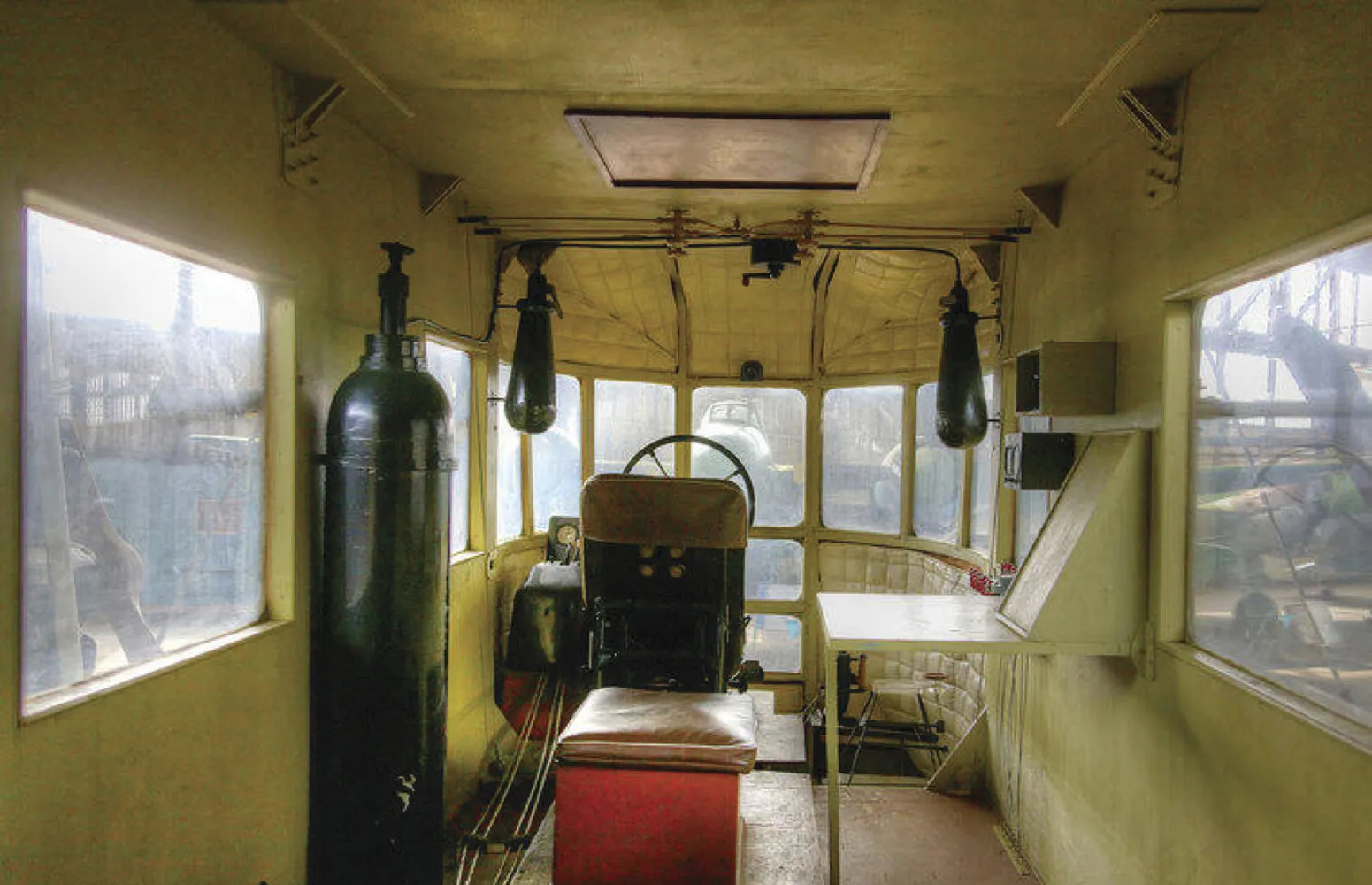
It looked like children playing 'airplane' with garden furniture. Today, such large windows can only be seen in design concepts of future spacecraft: this is related to flight altitude and cabin airtightness.
The Lawson Airliner cabin, 1919
The Boeing 787 cabin, 2019
1920s
Before you is the Sikorsky S-38 — an aircraft with wings above the cabin, offering a panoramic view. These aircraft flew to Hawaii. The flight was hard to call comfortable: the cabin swayed like a pendulum, and in the cabin where eight passengers were seated on woven seats, it was very noisy and cold.
Before the airport in Hilo was built, the aircraft would land on water: passengers would get off the roof and jump into canoes that transported them to shore.
In the mid-1920s, there were the first attempts to make the airplane cabin more comfortable. Curtains made of textile, baggage racks, movies shown during flights, and waiters offering drinks were introduced: two seats in the tail of the cabin were removed, and a small bar was added.
The Handley-Page cabin, Imperial Airways London, 1925
1930s
By the beginning of the 1930s, interiors still didn't look like those we're used to today, but the seats were already comfortable and there was much more legroom than now. The ceiling height in the cabin reached three meters — oxygen masks weren't yet available at that time.
The Ford Tri-Motor cabin — the first liner that started the airline industry in America
The 1930s of the XX century were the golden age of Art Deco. Its main features were also seen in aircraft interior design: seats made from expensive wood, crystal chandeliers, painted surfaces, decoration with leather and luxurious fabrics. Walls were decorated with chrome clock faces showing speed and altitude — prototypes of flight status displays (real-time flight information).

Designers of that time were inspired by the interiors of first-class train cars, and in the mid-1930s, aircraft cabins resembling the East Express wagons appeared, with seats facing each other and tables. Passengers could smoke, play cards, and stewards would serve drinks.
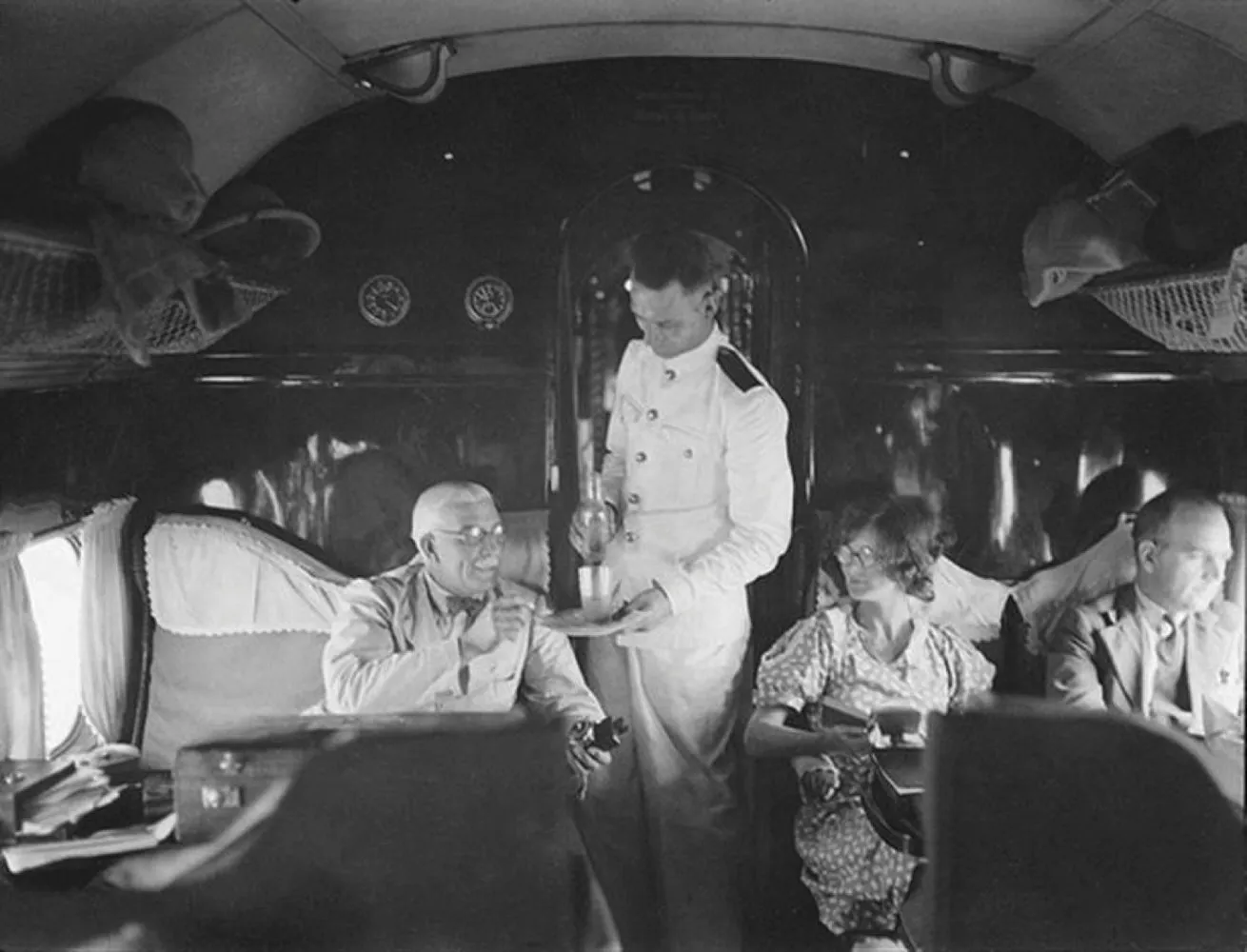
Some airlines offered sleeping accommodations on board: passenger seats could fold down, and upper berths were mounted directly to the wall and could be folded back when needed. The interior of such sleeping cabins resembled the familiar sleeper car of a train.

1940s
By the end of the 1940s, larger airliners already had sealed cabins, allowing them to fly at higher altitudes and avoid turbulence. As a result, the windows became smaller, and the cabin size increased. Safety requirements became stricter, so constructors focused first on creating comfortable flight conditions.

The DC-3 cabin, 1940
After World War II, many military aircraft were converted into commercial ones: the Boeing 377 Stratocruiser set a new standard for luxurious air travel with its very wide passenger cabin, a drinks lounge on the lower deck, and a galley where hot dishes were prepared.
In the lounge area, there was a large sofa in the shape of the letter 'P', which anyone could use to sit down, but the number of passengers should not exceed 14.
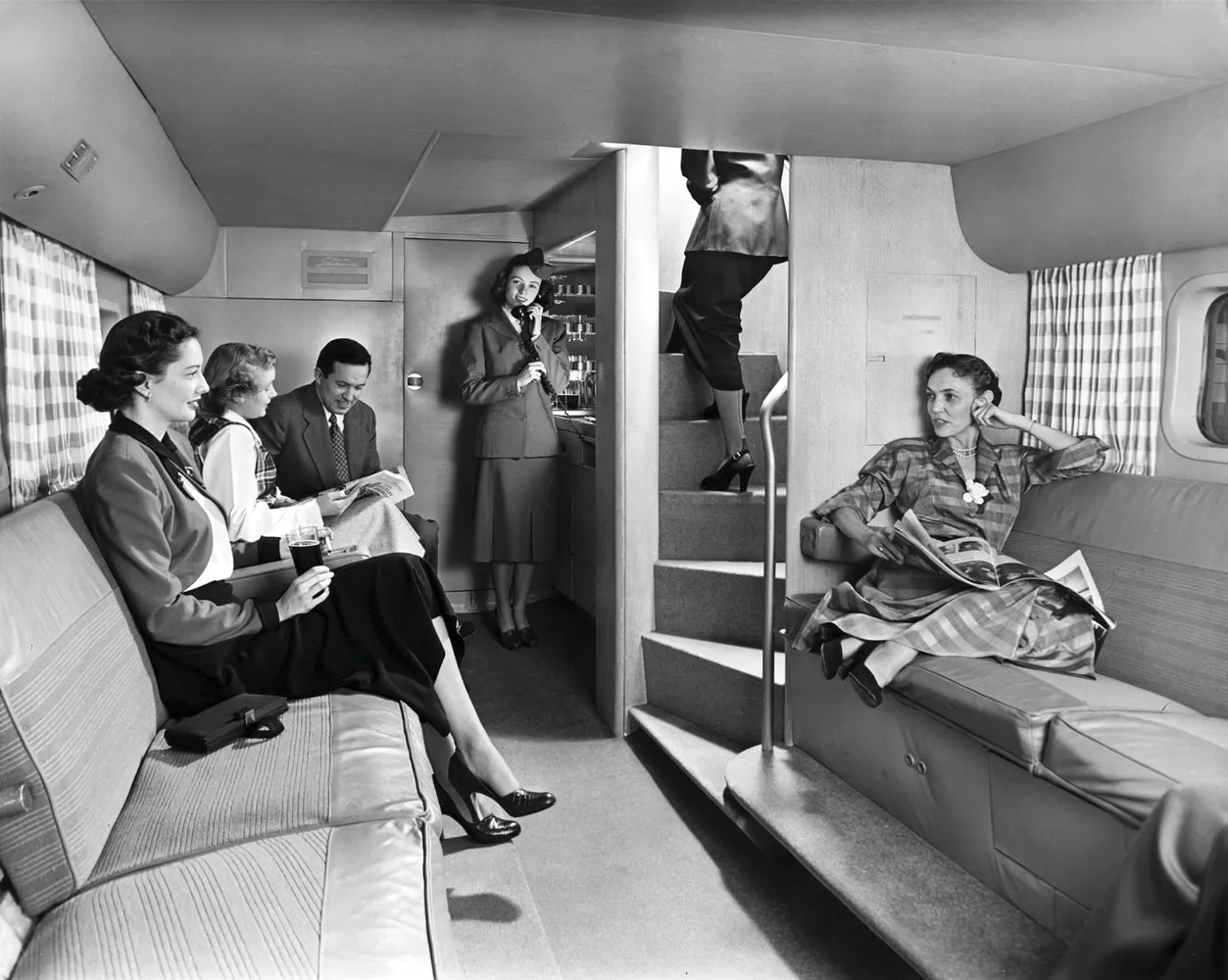
The seats were spacious and comfortable, and textiles were increasingly used for their production. Curved nooks in the ceiling — beds with mattresses, sheets, blankets, and pillows. Each sleeping space was equipped with a reading lamp and curtains, and in the morning passengers were offered breakfast in bed.
1950s
These years are called the Golden Age of civil aviation. Flights became much more popular, although not everyone could afford them: a trip on an airplane cost four to five times more than today. Nevertheless, passengers received what they paid for: luxurious interior, comfortable seats, and exquisite dishes — ribeye steak, lobster, and caviar were common components of the in-flight meal.
Why did such interiors eventually disappear?
This is primarily related to passenger safety. For example, there were glass partitions that separated first class from economy. These dividers looked magnificent but could shatter and scatter into fragments during crashes or turbulence.
Since aircraft interiors were not designed with safety in mind, even a trip to the toilet could be fatal: a sudden descent might cause passengers to land on sharp edges of tables or chairs.
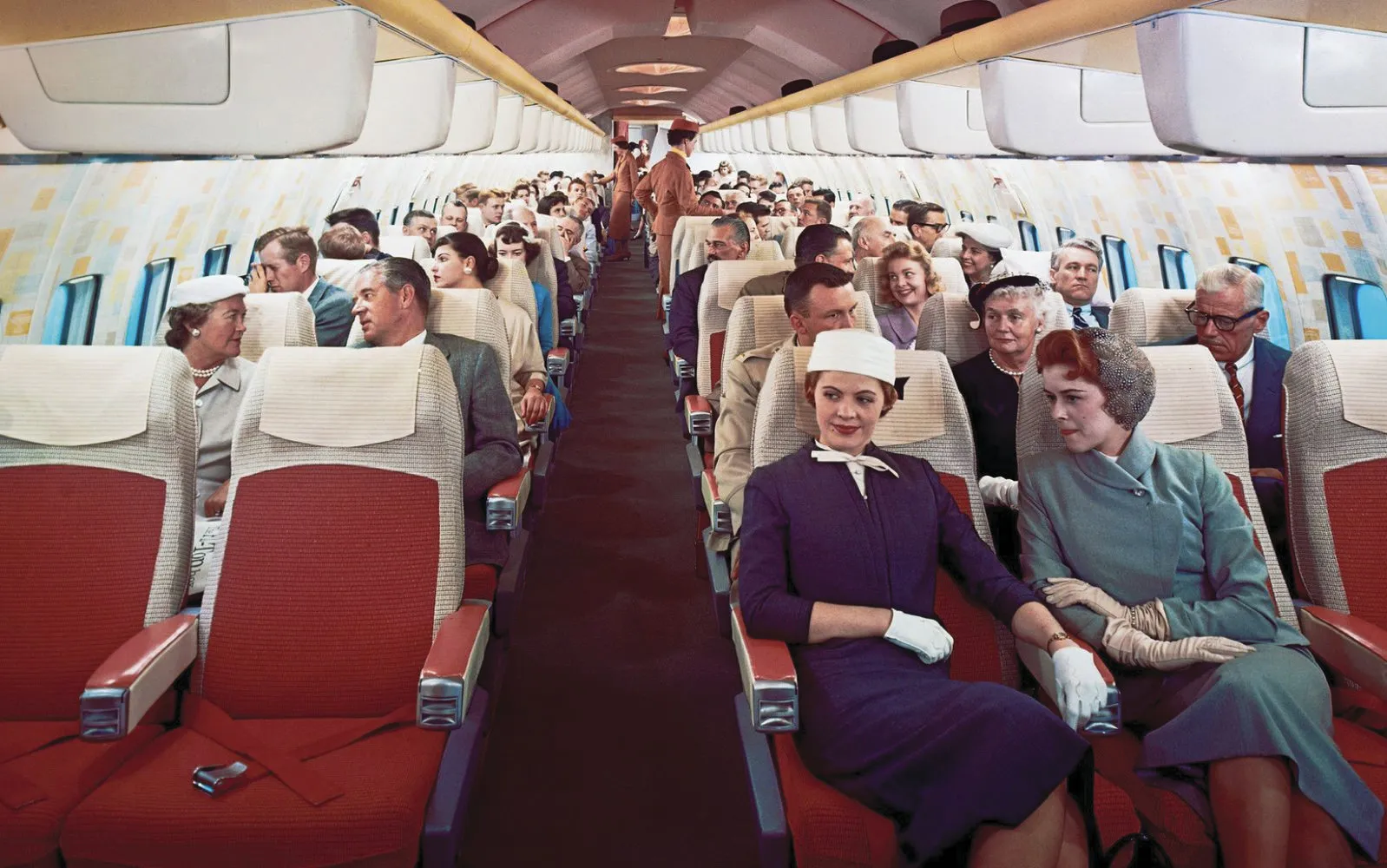
General trends were reflected in the interior as well: bright colors, unexpected combinations of materials and surfaces. Ceilings and walls were often covered with fabrics. In the post-war period, new low-cost materials were used — plastic, plywood, and leather substitutes.

1960s
The end of the 1960s marked the beginning of the 'Jumbo Jet' — the Boeing 747, which opened the skies to millions of travelers who couldn't afford it before. Flights became more accessible, and passengers no longer dressed as they did earlier, but the seats were still wide and there was plenty of legroom.

It was in the 1960s that the first cinema screens appeared on board — movies were shown at the front of the aircraft, and passengers listened to the sound through headphones. Larger aircraft had two screens: one for first class and one for economy.
By the way, notice the tables: they look very much like modern ones.
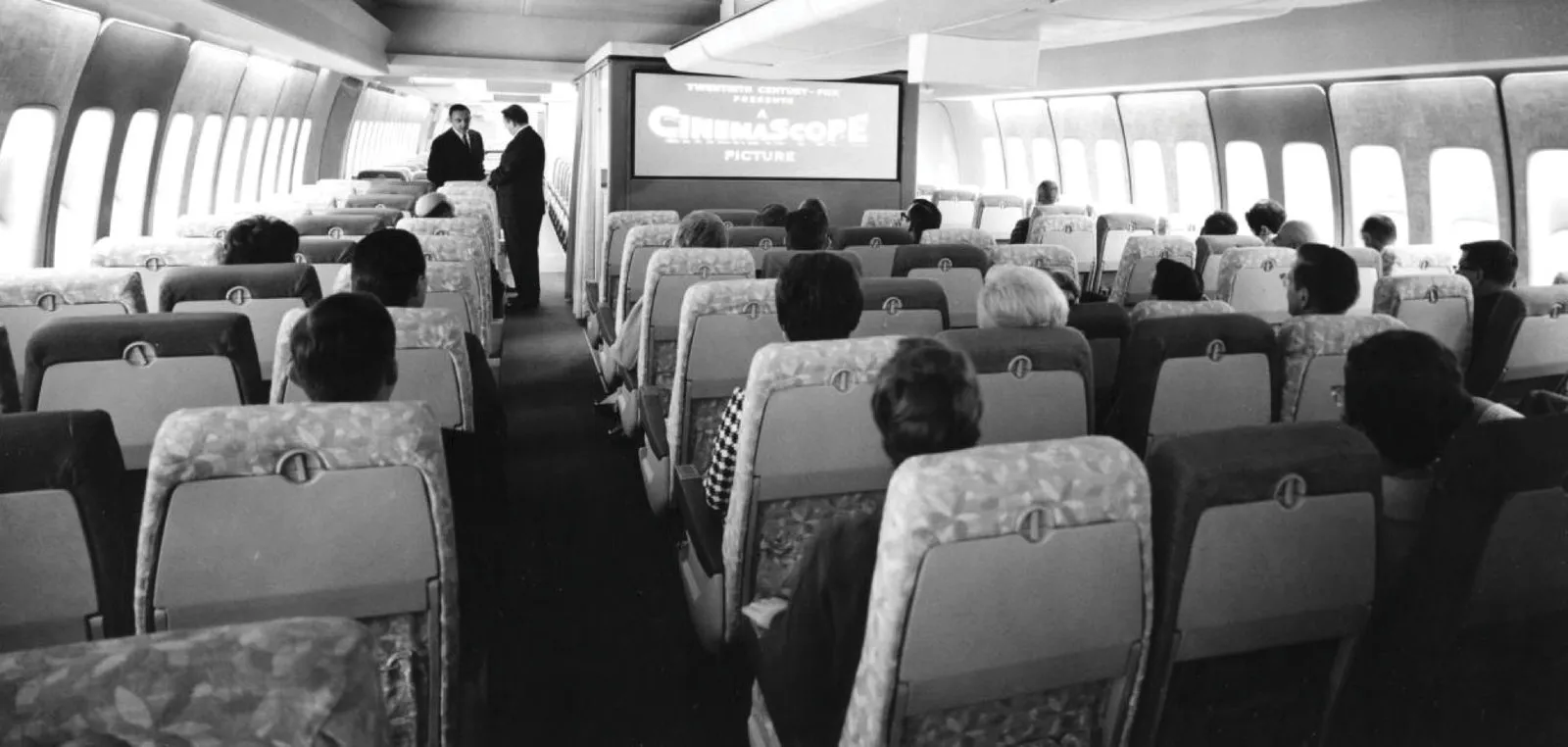
1970s
The bold 1970s were known for bold prints and large ornaments in the finishing. The disco style with fluorescent colors and built-in lighting became trendy. However, despite the external romance and lightness, functionality and practicality remained paramount.
Instead of the typical rows of seats, first and business class occupied space similar to a spacious bar where passengers could gather around a coffee table and chat.

Such privileged zones were decorated with vibrant decor, designer furniture, and equipped with Wurlitzer electronic pianos. Moreover, each passenger could stand upright: at that time, there were no overhead luggage racks and ceilings were tall.
In 1976, Singapore Airlines redesigned its first-class upper lounge and installed sofas that transformed into beds.

1980s
In the early 1980s, passengers could bring any amount of carry-on luggage, smoke as much as they wanted, and consume unlimited alcohol on board.
However, a lot changed with the introduction of new safety requirements. In 1985, the FAA (Federal Aviation Administration of the USA) developed a new standard for aircraft interior panels. The standard required that all commercial flights use fire-resistant panels with low heat emission.
By 1986, floor lighting appeared in aircraft to facilitate passenger evacuation during emergencies, and the ceiling and side walls of cabins acquired the familiar white color and smooth contours that reduced shading in the cabin.

1990s
In the 1990s, airplane cabins were equipped with built-in TVs and the first information screens, baggage compartments increased in size, and upholstery colors contrasted with light ceiling and wall panels.
Wide 'crib-like' seats, equipped with adjustable headrests and leg supports, sometimes even with massage functions, appeared.
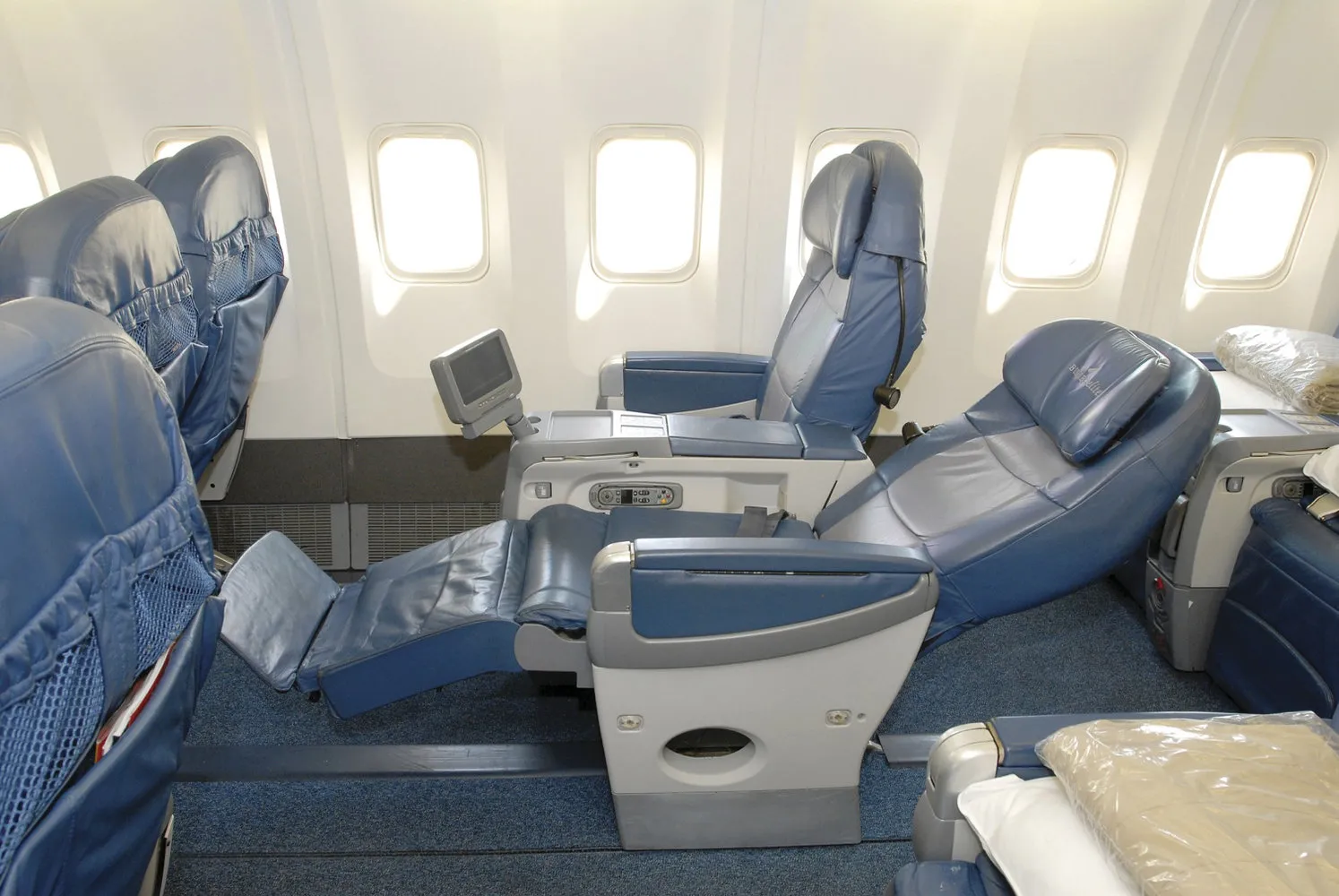
2000s
The cabin became more spacious, and overhead compartments more spacious. Seating arrangements varied from four seats per row in first class to 11 seats in economy. Built-in screens in the seats appeared — this allowed each passenger to choose and watch what they wanted.
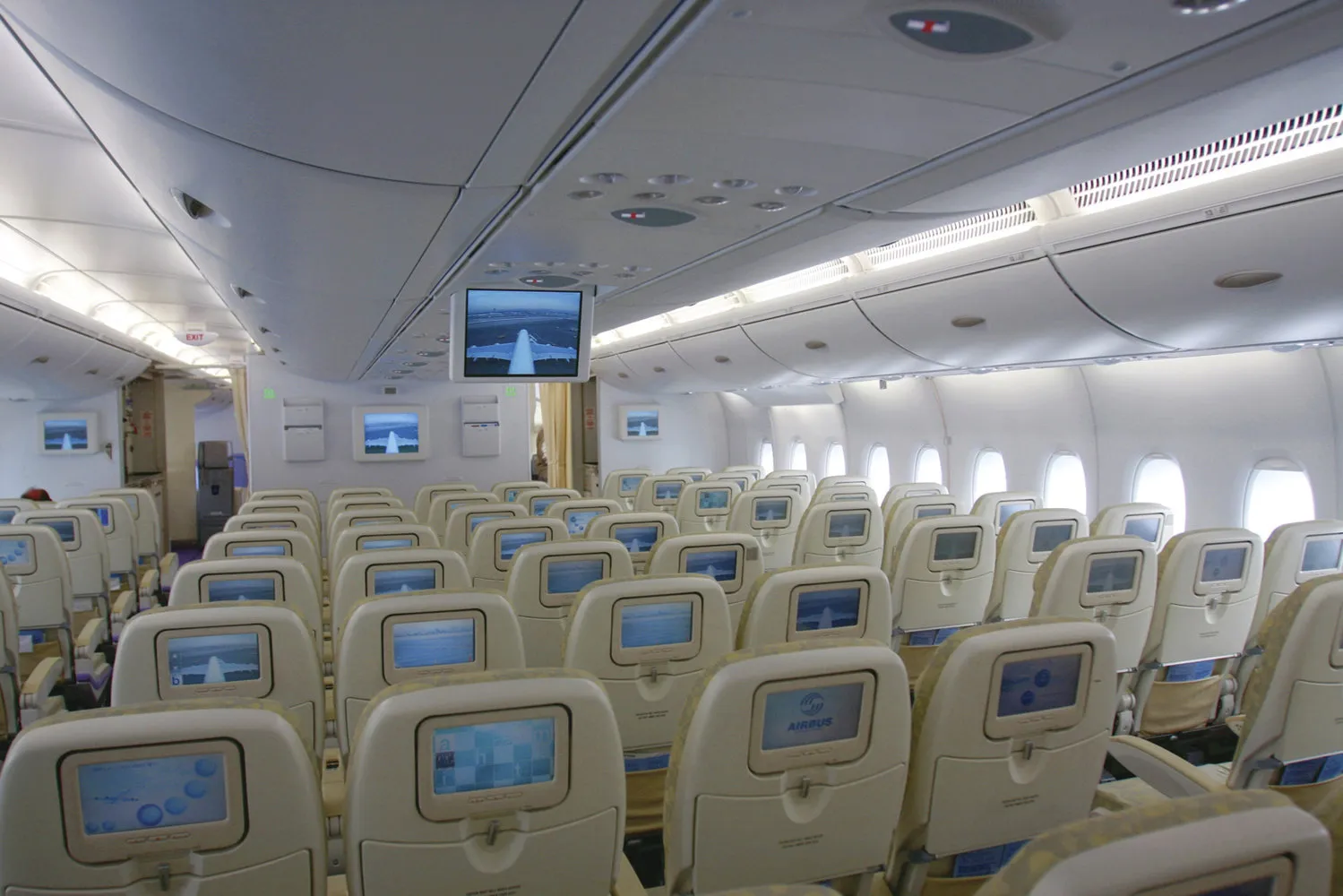
The Airbus A380-800 cabin
At the beginning of the 2000s, British Airways was the first to equip business class with flat beds. Each such seat was equipped with a personal screen, remote control, and a reading light.
The cabin design varied from airline to airline, but common trends were still evident: soft and calm colors, smooth forms, and matte plastic in the finishing. The seat upholstery still used both textiles and leather, often combining them.

2010s
In our time, flights have finally stopped being a luxury and have become accessible to many. To increase the number of passengers on board and boost profitability, airlines choose narrower seats and move the rows closer together.

The difference between business class and economy becomes more evident. To stand out from competitors and maximize comfort in a small space, airlines collaborate with famous designers and offer their clients ergonomic seats, innovative gadgets, and for first-class passengers even separate smart cabins.
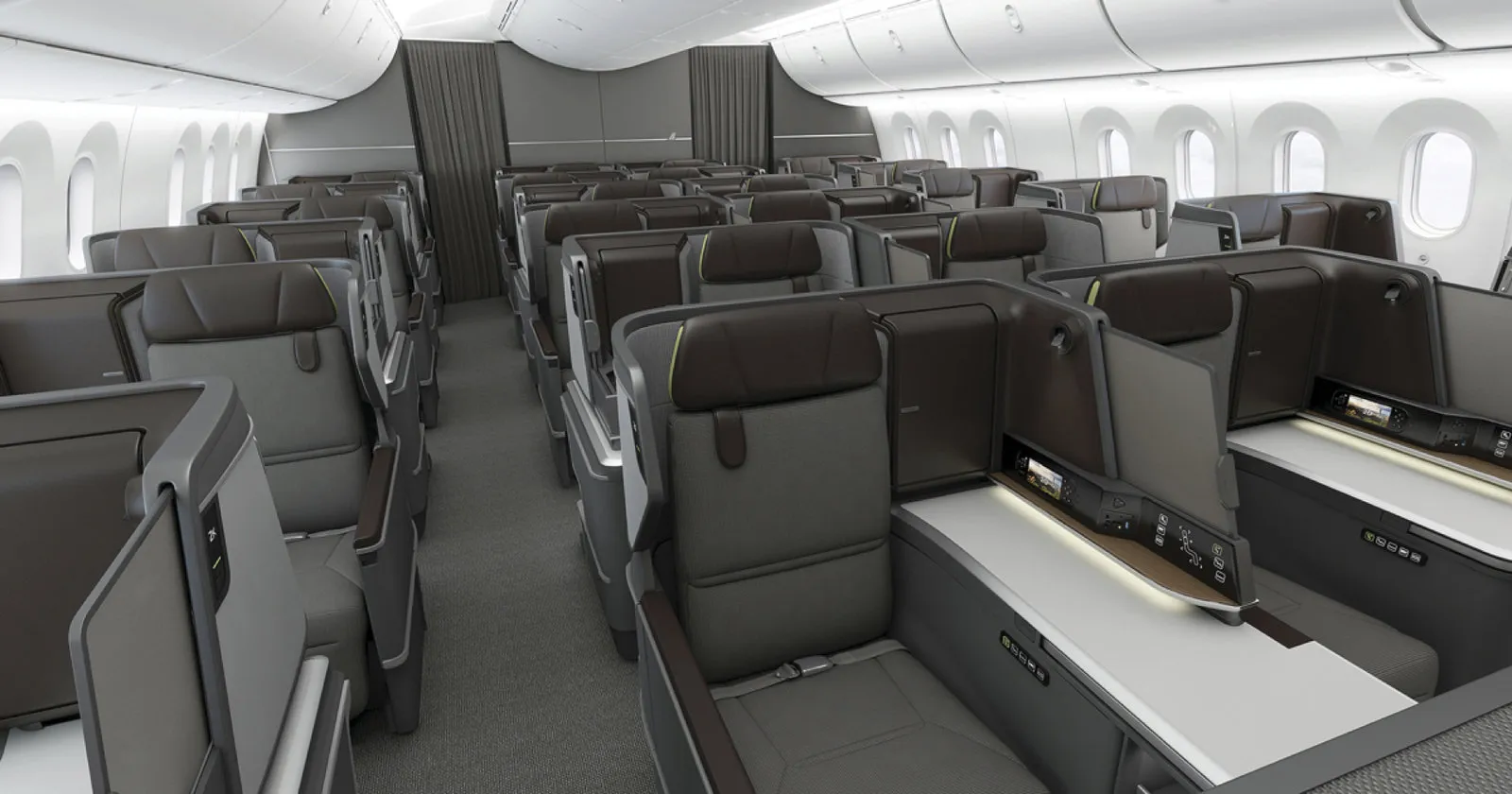
The business class cabin of BMW Designworks studio for EVA Air Taiwan's aircraft
Double-bed cabins for first-class passengers. The seat and ottoman are made of Poltrona Frau leather — the same material used in Ferrari and Alfa Romeo cars. The width of the seat in Singapore Airlines' business class is 50% wider than that of other airlines, plus a pleasant addition — a decorative pillow with a classic 'goose foot' pattern.
More articles:
 11 Posts for Owners of Small Apartments
11 Posts for Owners of Small Apartments Coffee Enthusiast's Wishlist: Selection by Co-Founder of 42coffeeshop
Coffee Enthusiast's Wishlist: Selection by Co-Founder of 42coffeeshop Where to Save Money During Apartment Renovation?
Where to Save Money During Apartment Renovation?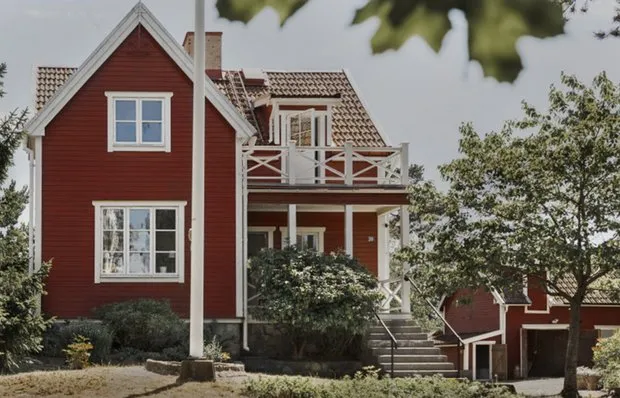 Cottage in Sweden with an easy-to-replicate interior
Cottage in Sweden with an easy-to-replicate interior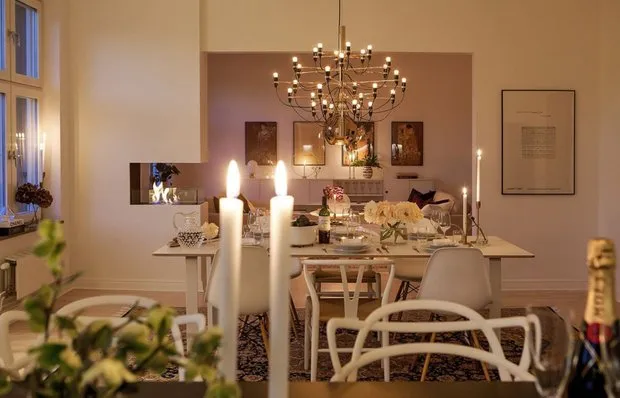 Interior with Beautiful Lighting: Apartment in Malmö
Interior with Beautiful Lighting: Apartment in Malmö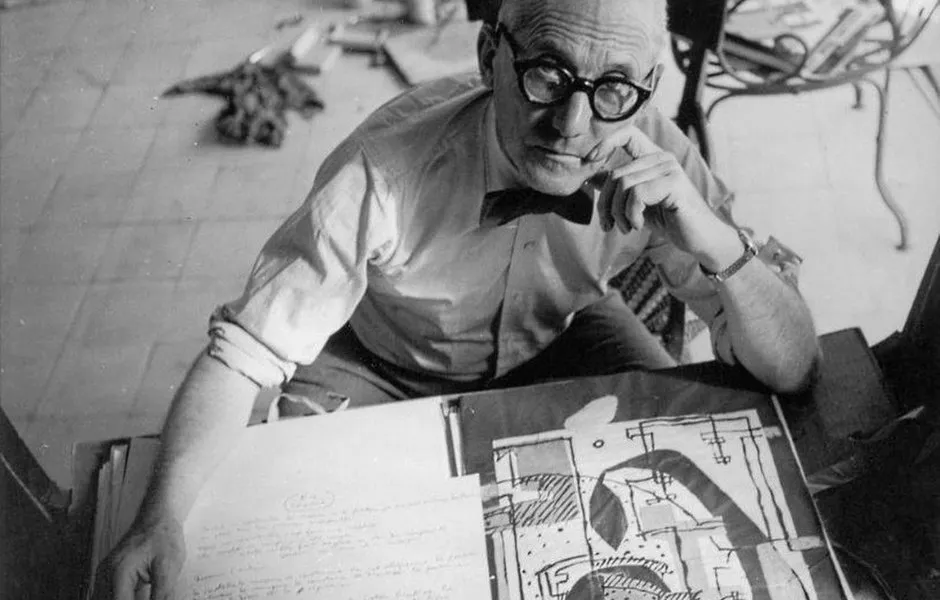 Le Corbusier: 30 Best Photographs
Le Corbusier: 30 Best Photographs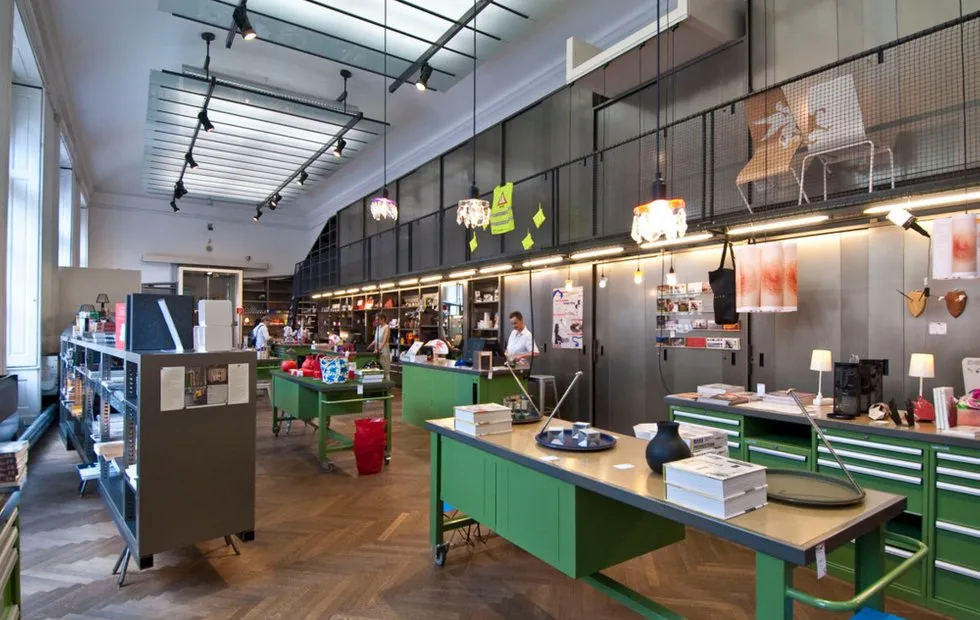 Vienna for Designers: Guide to the Most Interesting Places
Vienna for Designers: Guide to the Most Interesting Places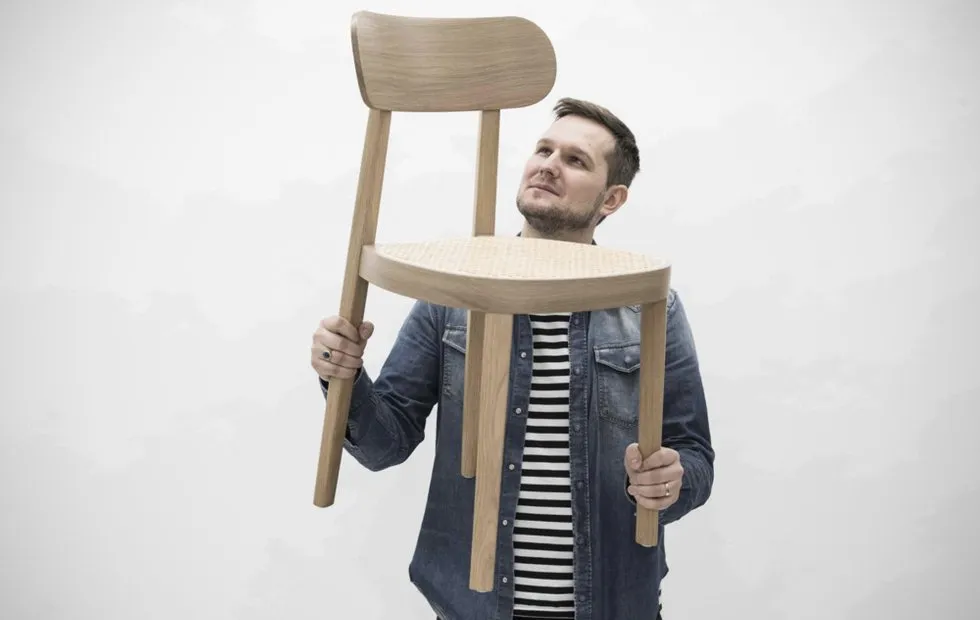 10 Things You'll Want to Know About Sebastian Herkner
10 Things You'll Want to Know About Sebastian Herkner